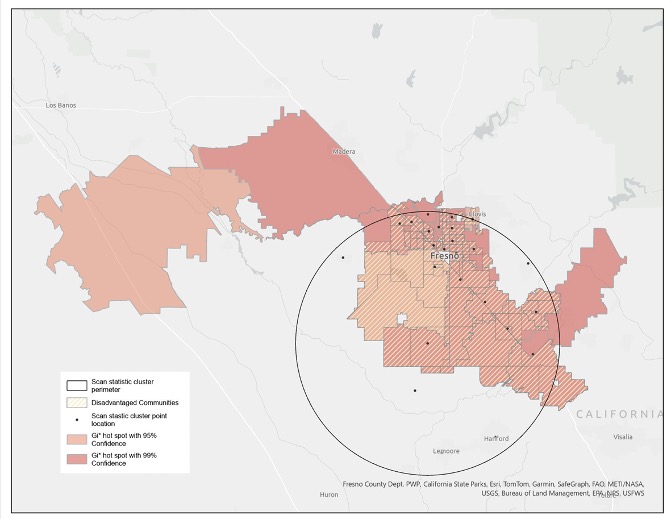Environmental Health 1
Session: Environmental Health 1
449 - Environmentally Disadvantaged Communities (DAC) and Asthma Clusters
Sunday, April 27, 2025
8:30am - 10:45am HST
Publication Number: 449.4886
Daisy Valdivieso, University of California, San Diego School of Medicine, La Jolla, CA, United States; Sydney leibel, Rady Children's Hospital San Diego, San Diego, CA, United States; Alexandra Heaney, University of California, San Diego, San Diego, CA, United States; Carlos F. Gould, University of California San Diego, San Diego, CA, United States; Margaret B. Nguyen, University of California, San Diego School of Medicine, San Diego, CA, United States

Daisy Valdivieso (she/her/hers)
Medical Student
University of California, San Diego School of Medicine
La Jolla, California, United States
Presenting Author(s)
Background: In concordance with Senate Bill 535, Cal Environmental Protection Agency designated the state’s top communities with the highest quartile of pollution scores as Disadvantaged Communities (DACs). The DAC designation provides access to economic investments aimed at mitigating pollution’s negative effects. Asthma is the most common chronic disease among children. While causes of asthma are poorly understood, literature supports exposure to pollutants can exacerbate asthma attacks. Children suffer disproportionately from asthma compared to adults and distinct geographic clusters for child asthma are known to exist in California. In this study we query if communities that demonstrate cluster patterns for child asthma also meet criteria for DAC designation. If the DAC designation coincides communities with disproportionate outcomes such as asthma exacerbations, then this designation may be an important tool to guide environmental investments that can impact child health.
Objective: Our objectives were to 1) identify ZIP codes located in clusters for asthma ED visits and 2) assess the proportion of ZIP codes within these clusters that are also identified as DAC.
Design/Methods: We obtained age-adjusted rates of asthma ED visit from California Health and Human Services Agency for children 0-17 years by ZIP codes. The DAC dataset was abstracted from the California Office of Environmental Health Hazard Assessment. To detect spatial clusters, we deployed two spatial approaches, spatial scan statistic and Getis Ord Gi*. ZIP codes identified in both approaches were determined to be significant clusters.
Results: The median age-adjusted rate of asthma ED visits across California was 57.8 per 10,000 children per ZIP code. Spatial scan statistic demonstrated the primary cluster with 25 ZIP codes (cluster RR =2.1, p < 0.0001). Gi* identified 16 hot spots with 95% confidence and 51 hot spots with 99% confidence. The 20 ZIP codes identified as clusters in both approaches were clustered in Fresno, CA. Of these, 18 (90%) ZIP were designated as a DAC. The median age-adjusted rate of asthma ED visits in twenty ZIP codes identified within the cluster was 148.8 per 10,000 children.
Conclusion(s): Ninety percent of ZIP codes identified in the primary spatial cluster of child asthma ED visits were identified as a DAC. In terms of child asthma outcomes, the DAC appears to correctly capture negative health consequences associated with environmental pollution. These findings may inform future environmental policies to positively impact child health equity.
Figure 1. Communities with clustering for pediatric asthma ED visits.
 Spatial scan statistic demonstrated the primary cluster (black circle) containing 25 ZIP codes (black dots) within its perimeter. RR= 2.1, p < 0.001. The Gi* approach identified sixteen hot spots with 95% confidence (light orange) and 51 hot spots with 99% confidence (dark orange). The overlap of these approaches identified twenty ZIP codes as clusters of pediatric asthma ED visits.
Spatial scan statistic demonstrated the primary cluster (black circle) containing 25 ZIP codes (black dots) within its perimeter. RR= 2.1, p < 0.001. The Gi* approach identified sixteen hot spots with 95% confidence (light orange) and 51 hot spots with 99% confidence (dark orange). The overlap of these approaches identified twenty ZIP codes as clusters of pediatric asthma ED visits. Table 1
Image 10-31-24 at 10.19 AM.jpegTwenty ZIP codes were identified as clusters in overlapping spatial statistical approaches. Eighteen (90%) of these locations were designated as a Disadvantaged Community.

